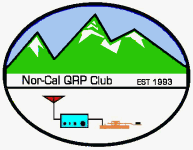NorCal Doublet Antenna
By Doug Hendricks, KI6DS
The NorCal Doublet Antenna came about due to my desire for a simple antenna
that could be erected very fast, only needed one center support, and did not
take up much storage room. Dave Gauding, NF0R, is a close friend of mine, and
he had told me about a St. Louis Doublet, that used small wire for the
radiators and computer cable for the feedline. I took his idea a step farther,
and used computer cable for the whole antenna. Jim Duffey, KK6MC/5 and Dennis
Foster, KK5PY, also contributed to the design.
Jim was the one who told me that if I made the legs 22 feet on a side that the
antenna would have basically the same radiation patterns on all bands from
40 - 10 meters. This would be very handy to have for field operation, so I
decided to use it.
Here is how to make the NorCal Doublet. You will need the following materials:
50 feet of 4 stranded computer cable
1 #0 Fishing Swivel
1 Cable tie
2 pieces of fishing cord
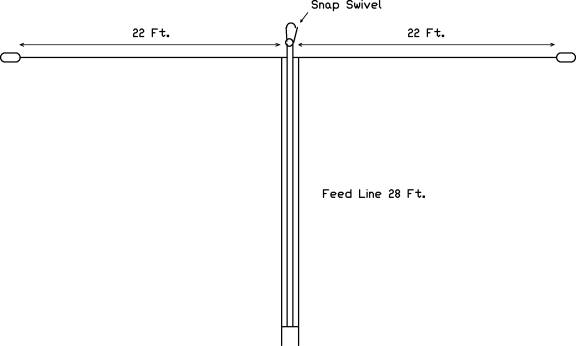
1. Take the computer cable, and strip the outer two conductors down 22 feet,
leaving the two middle wires connected together.
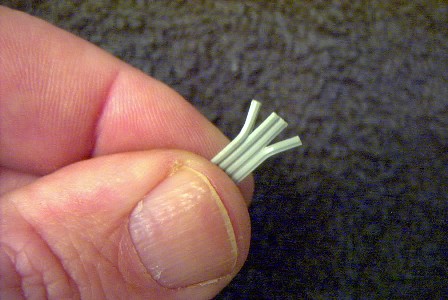
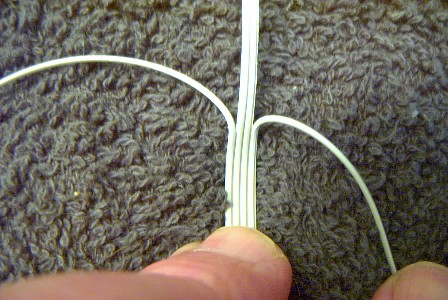
2. Cut the two middle wires off about 2" above the 22 foot mark where you
stopped stripping the outer connectors.
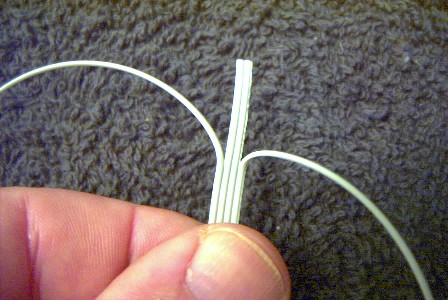
3. Loop the 2" piece of double strands over the eye of the fishing swivel.
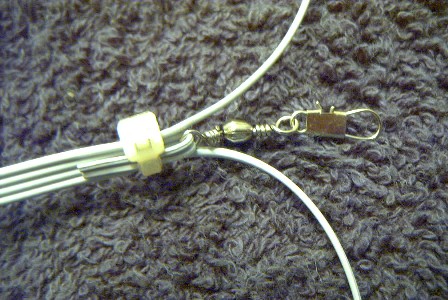
4. Secure the whole thing by wrapping the tie wrap around the feedline and loop.
(Dennis Foster showed me this idea)
5. Use the remaining 28 feet of 4 conductor cable as the feedline. The outer
two wires will be the feedline. Strip off about 1" of insulation on both outer
connectors to hook to your NorCal BLT tuner.
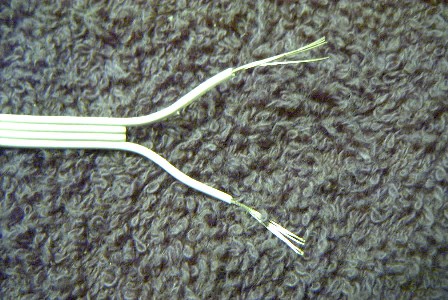
6. Tie a loop on each end of the two 22 foot wires.
7. Tie the fishing cord to the loops.
8. To erect the antenna, clip the fishing swivel to the eye of the 20 foot
fishing pole. Extend the pole and set it up. Stretch out the two 22 foot
wires and tie off the strings to suitable supports. Connect the feedline to
your tuner, and get on the air.
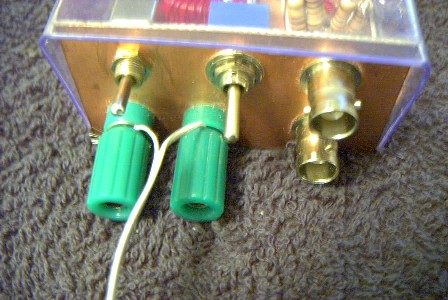
Thank you for putting the NorCal Doublet on the internet. It's an
amazing idea. By doubling the size and that's all I can accommodate on
my lot, it turned out to be a real multiband antenna for me including
the 160m band.
I peeled off 4-wires out of a 30m multiwire flat computer cable, it was
all I had in terms of length, to end up with 2 x 15m doublet supported
by collapsible pole and 15m of feeder. The feeder allows vertical down
lead, horizontal run and is easily squeezed by the rubber seal in the
window frame entering the shack. No need for a hole in the wall allowing
operation even with the window closed. It's getting cold in winter time
here. I shoud mention, that we have wooden frames made from Oregon with
insulated double glass panes. Anyway, the antenna dimensions allow me to
operate from 80-10m with a balanced line tuner. I used so far BLT down
to 40m and ZM-2 down to 80m.
Little tinkering and testing revealed that the antenna works pretty well
on 160m connecting one leg to the centre of coax and the ground of the
trx to the down spout and grounding cable of the lightning protection of
the house.
Shorting the two wires of the feedline at the lower end and operating
against ground provided resonance at around 1,6 MHz. But connecting one
leg of the feed line only introduces some capacitance to "shorten" the
antenna electrically thus shifting the resonance, as in my case, exactly
to the 160m band. I was excited about the possibility to get onto the
160m band without trimming or the need for any tuning elements. It seems
that the whole thing works like an "off-centre fed", capacitively
shortened ground plane providing 50 Ohms matching. Of course there will
be some resistive loss in the ground system as the SWR approaches just
1,5 at 1810 and 1910 kHz and drops to 1 in between.
During the All Austrian 160m contest I hooked up my TS50 in lack of a
real qrp rig and used 10, 50 and 100 W output in CW to log Austrian
stations and 19 other European DXCC countries reaching out as far as
into Russia, some 1700 kilometres.
Using the antenna as doublet on 20m together with the KX1 provided a
contact to Ethiopia, which is a distance of around 4500 km.
72, Hermann
OE1HFC
Doug and co.
I just wanted to drop you a line to let you know that I love the NorCal
Doublet! I've only been licensed since 22 September 2005.
One of my problems was finding an antenna that wouldn't distress the XYL
too much, that was cheap and that I could use at home and portable. I
found
your website after doing plenty of searching and decided to give the NorCal
Doublet a go. So I got hold of the computer ribbon cable, bought a couple
of 8 metre fibreglass fishing poles (one for home, one for portable) off a
seller on ebay (£5.99 each , brand new) and spent a few minutes making the
antenna. Also made a homebrew W1CG 4:1 balun to feed it, and bought a
Elecraft T1 atu (yeah, I know, I should have built a BLT but time is of the
essence with 4 kids!).
Well, I made one and was so pleased that I now use that permanently at
home, and made another for portable. Using 5 Watts SSB I have had amazing
contacts on 40, 20, 17, 15 metres, even at this lowly time in the sunspot
cycle. Best DXs have been 2 QSOs with Brazil, and also a few with the US
(Connecticut and Pensylvania) and heaps through Russia, Iceland,
Scandinavia and other parts of mainland Europe. All this from my back
garden 3 miles east of Brighton, on the south coast of UK.
Thanks so much for putting this design on the NorCal QRP Club website. I'm now
addicted to QRP, am so pleased I didn't follow the route of purchasing
over-rated antennas, and am so pleased that I didn't make an antenna that
I'd have to fiddle about with for ages to tune it. I can't help spreading
the word about how good the NorCal Doublet is.
All the very best 73s.
Pete Millis M3KXZ G-QRP 11767
Brighton UK
